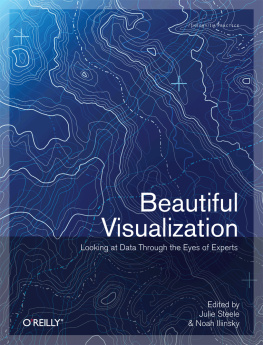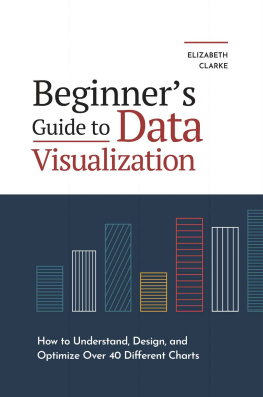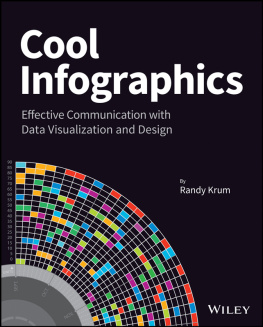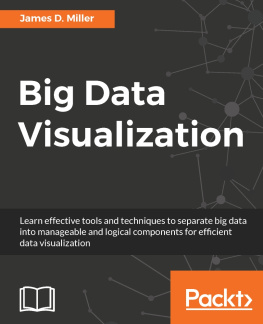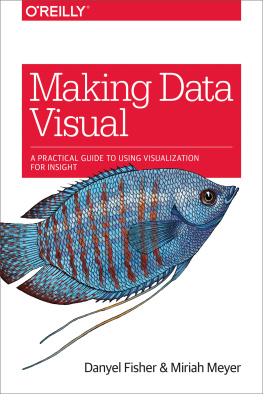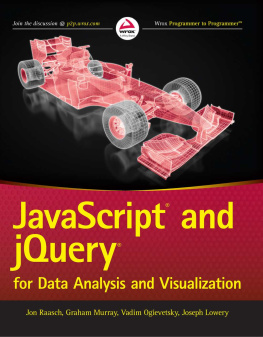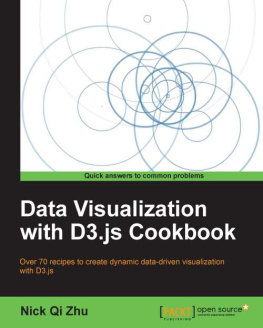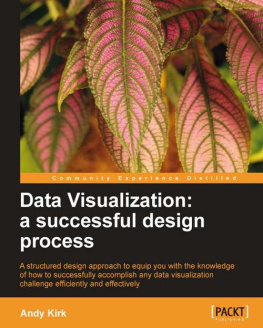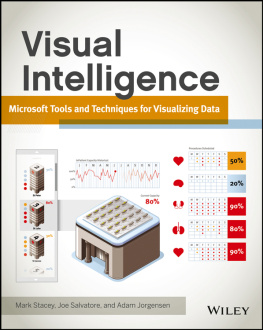Designing Data Visualizations
Julie Steele
Noah Iliinsky
Copyright 2011 Julie Steele and Noah Iliinsky
OReilly books may be purchased for educational, business, or sales promotional use. Online editions are also available for most titles (.
Nutshell Handbook, the Nutshell Handbook logo, and the OReilly logo are registered trademarks of OReilly Media, Inc. Designing Data Visualizations , the image of a gang-gang cockatoo, and related trade dress are trademarks of OReilly Media, Inc.
Many of the designations used by manufacturers and sellers to distinguish their products are claimed as trademarks. Where those designations appear in this book, and OReilly Media, Inc., was aware of a trademark claim, the designations have been printed in caps or initial caps.
While every precaution has been taken in the preparation of this book, the publisher and authors assume no responsibility for errors or omissions, or for damages resulting from the use of the information contained herein.

O'Reilly Media
Preface
The path from journeyman to master is long. In the case of data visualization, the path has been well marked by many accomplished designers and cognitive scientists who have been doing great work for decades. We gladly follow in their footsteps, and we hope you will, too.
In these pages, however, our goal is not so much to take you to the summit as to start you down the pathand that the path is quite rewarding to travel. Our goal is to give you confidence as you begin your journey.
Many statisticians and practitioners with excellent coding and data munging skills are nevertheless stuck in a rut of common formats and default settings, which lead to mundane, suboptimal visualizations. But the domain of hand-crafted, fine-tuned, noteworthy visualizations is not limited to creative types; it is accessible with a bit of guidance.
The truth is, there is plenty of room for artistry and creativity in data visualization. But success is built upon a linear process that encodes information for visual transmission and subsequent decoding by wetwarethe readers brain. One aim in writing this book is to introduce you to this process, including some basic concepts and best practices, so that your message may be transmitted with minimal interference.
It is a process. And design is something youre probably already doing, whether youre designing applications, frameworks, graphics, or something else. Design is simply a process of organized thinking, planning, and executing. You are making design choices, intentional or not. Of course, intentional choices have a better chance of being useful than arbitrary or accidental choices.[] This book is a road map to those choices: it is meant to make you aware of the choices you get to make, and to help you make useful, intentional design decisions at every turn.
This high-level road map is one we havent seen presented anywhere else. It will give you the general lay of the land. It is a set of steps and rules to follow that will get you 80% of the way to turning out great work. Well introduce many questions youll need to ask yourself, and point you in the direction of some answers. The nuanced details of those answers have already been addressed by others, and we hope you will continue down the path with further guidance from our colleagues and mentors (see the Reading List in ).
Note that also covers some of the many tools available for creating data visualizations, and we hope you will peruse them. But youll find a discussion of tools intentionally missing from the rest of the book, because the topic at hand is, What problem are you solving? (and the questions youre answering), rather than, What tools are you using? Design and implementation are two separate things.
As in any creative discipline, the best data visualizations are forged by breaking some of the rules. But rules must be broken with intention. One must learn the rules (well, more like guidelines) before one is entitled to break them. With that in mind, we present for your consideration our process for the visual encoding of information.
How This Book Is Organized
This book is organized into two major parts, which can loosely be thought of as practical theoretical foundations and applied suggestions, respectively.
In , we discuss different kinds of visualization (including infographics and visual art) and explore the influences at work in each one. The goal is to help you become a more savvy consumer of visualizations, as well as a more organized thinker when creating your own visual work.
In , we introduce some ways of classifying and describing different styles of visualization, so that you can begin to think about and describe what youre designing.
In , we introduce the three fundamental influences to the visualization productthe designer, the reader, and the dataand describe how each should shape what is eventually created.
In , we apply these concepts to the design process. The goal is to help you think in a linear way about how to select and apply appropriate encodings for your data.
In , we focus on getting to a clear understanding of your goalsand defining the requisite supporting dataso that you can implement them most effectively.
In , we lay out heuristics for understanding the shape of your data and choosing compatible visual properties and structures with which to encode it.
In , we dive deep into the property of spatial position axes and placement one of the most important properties youll need to select. We also discuss using different visualization structures.
In , we look at best practices and offer specific suggestions for encoding many specific different data types with visual properties. We also present warnings against common pitfalls and dark patterns.
Finally, the Appendices are full of resources and references meant to help you put your skills into practice and expand your knowledge beyond this volume.
contains a list of tools to help you get started, as well as a suggested reading list to expand your knowledge and understanding of design concepts.
is a list of the questions and decisions youll confront as part of the design process. We hope youll read the entire book, and then use this section as a refresher whenever you design a new visualization.
[] Suh: The Principles of Design (Oxford University Press); Schon: The Reflective Practitioner (Basic Books).
What We Mean When We Say
In this book, well use some specific terms to describe your data and visual encodings. Here is a handy glossary for quick reference.
| Chart: Something that shows qualitative information (e.g., flow charts). |
| Data dimensions: One single channel of data. A stock graph may comprise four properties: date, price, company, and market cap. Each is a unique dimension of the data, which can be encoded separately, with a different visual property. |
| Data visualization: Visualizations that are algorithmically generated and can be easily regenerated with different data, are usually data-rich, and are often aesthetically shallow. |
| Designer: The creator of a visualization; any reader of this book. |
| Encoding: The visual property (noun) applied to a dimension of data that encodes (verb) the information into a visual medium for decoding by the readers brain. |


